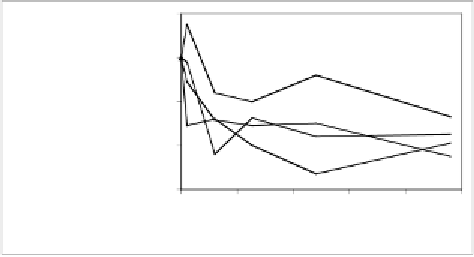Biology Reference
In-Depth Information
inhibitory with a maximum 27% reduction compared with the amount of
TNFα produced in LPS-only positive controls. Derivatives
83
(at
23 μM) and
84
(at 3 μM) were found to be somewhat more potent at
approximately 44% inhibition. The
meta
-phenyl linked analogue
85
(at 11.8 μM) was the most satisfactory antagonist, with a maximum
inhibition of 53% compared to positive control. Since all four
compounds were somewhat antagonistic towards LPS (lipid A) in this
TNFα secretion assay, analogues
83
and
86
were chosen for further
in
vivo
testing because they had proven to be the least capable of promoting
undesirable IL-1β release.
120
TNF
α
(as %
of blank
control)
100
80
Analogue 83
Analogue 84
Analogue 85
Analogue 86
60
40
0
5
10
15
20
25
tannin analogue (
μ
M)
tannin analogue (
μ
M)
Fig. 6.25 Inhibition of LPS-stimulated secretion of TNFα from hPBMC's by the dimeric
tannin analogues
83
-
86
.
6.5.2.2
In vivo testing with live rats
Four restrained rats were dosed with 1 mg/kg of LPS followed by
20 mg/rat of
83
or
86
over a 3-hour period. In addition, saline was
administered as a negative control to a 5
th
rat, and four rats were treated
with LPS only. At 90 minutes, the animals showed a significant (≤ 50%)
reduction of serum TNFα levels when treated with either one of the
tannins
83
or
86
compared to rats dosed only with the positive control
LPS (Fig. 6.26). The IL-1β serum levels were also reduced an average of
17% compared to the LPS-only animals. Furthermore, rats treated with
compound
86
had a lower heart rate (385 beats/min) than the LPS-only
rats (483 beats/min). This value is within experimental error of the
resting heart rate of the saline-treated control rat (380 beats/min).


































